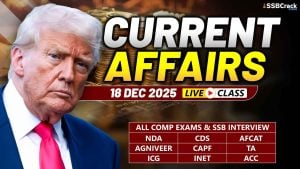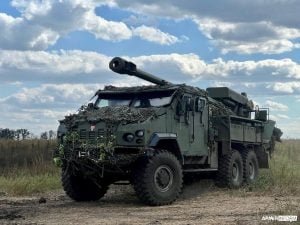Government decides to allow Invalid Pension to Armed Forces Personnel with less than 10 years of qualifying service
- The Government has taken a decision to allow Invalid Pension to Armed Forces Personnel with less than 10 years of qualifying service. Invalid pension is granted to the Armed Forces Personnel who is invalided out of service on account of disability which is accepted as Neither Attributable to nor Aggravated (NANA) by Military Service. The proposal has been approved by Raksha Mantri Shri Rajnath Singh. Benefit of this decision will be available to those Armed Forces Personnel who were in service on or after 04.01.2019.
- Earlier, the minimum period of qualifying service actually rendered and required for invalid pension was 10 years or more. For less than 10 years qualifying service, invalid gratuity was admissible. By this decision, Armed Forces Personnel whose service is less than ten years and became/become invalided out of service on account of any bodily or mental infirmity which is Neither Attributable to Nor Aggravated (NANA) by Military service and which permanently incapacitated/incapacitates them from military service as well as civil re-employment, will be benefited and it will make them economically sound.
Defence Ministry delegates capital procurement powers to Armed Forces
- Considering the security environment due to prevailing situation along the Northern Borders and the need to strengthen the Armed Forces for the Defence of our borders, a Special Meeting of the Defence Acquisition Council was convened on 15th July 2020 under the Chairmanship of Raksha Mantri Shri Rajnath Singh.
- The DAC delegated the powers for progressing urgent Capital Acquisition Cases upto Rs 300 crores to the Armed Forces to meet their emergent operational requirements. This will shrink the procurement timelines and ensure placement of orders within six months and commencement of deliveries within one year.
Raksha Rajya Mantri Shri Shripad Naik inaugurates conference on Aerospace and Defence Manufacturing Technologies
- Raksha Rajya Mantri Shri Shripad Naik has said Indian Defence and Aerospace industry today is on the threshold of transformation, under the several initiatives of Government of India to promote ‘Make in India’ and ‘Atmanirbhar Bharat’ Abhiyaan. He was delivering the Inaugural address at the 5th edition of the conference on Aerospace and Defence Manufacturing Technologies here today. Theme of the conference is Empowering India with ‘Aatma Nirbhar Bharat Mission’.
- Shri Shripad Naik exhorted that the Indian A&D industry has to rise to the occasion to shoulder greater responsibility in making the nation self-reliant in Defence Production and achieve 26 Billion US Dollar domestic production by 2025, which is the stated objective of the Defence Production Policy.
- Speaking about the challenge posed by COVID-19, Raksha Rajya Mantri said, “COVID has caused, across the globe, severe economic and social challenges… In our national efforts over the last four months, we have been successful to first create high awareness among our large population, build adequate capacity for testing and providing health care, and manage the rate of spread of virus.” Having taken steps to save lives of our people, we are now into the next phase of our national effort – That is to Save Livelihoods, he added hoping that the industry and economy will bounce back to their growth trajectories, as before COVID.
- In recent years, the defence sector has grown extensively. It has increased at a CAGR of 9.7 per cent from 2008 to 2016, reaching current levels of USD 42.83 billion in the year 2017-18. The Aerospace and Defence industry in India is estimated to reach around 70 billion Dollar by 2030. Shri Shripad Naik said, “India’s aerospace and defence market has tremendous growth potential and strong fundamentals to be globally competitive and further develop into a leading hub and net exporter for design, manufacturing, engineering, technology development and services.”
- The Indian civil aviation market is one of the fastest growing markets in the world with tourist footfall increasing at 20 per cent every year and the growth is expected to continue with the plan of investments of about USD 1.83 billion in the development of airport infrastructure by 2026. Speaking about global Aircraft Maintenance, Repair, Overhaul (MRO ) Raksha Rajya Mantri said , “Indian market is yet to catch up. The Indian MRO market is estimated at $800 million and is growing at about eight per cent annually against a four per cent world average.” The Indian civil Aviation MRO market, at present, stands at around $900 million and is anticipated to grow to $4.33 billion by 2025 increasing at a CAGR of about 14-15 per cent.
- Speaking about efforts made by Ministry of Defence over the years, Shri Shripad Naik said, “The Department of Defence Production has established wide ranging production facilities for various defence equipment through the Ordnance Factories, Defence Public Sector Undertakings (DPSUs) and encouraging private defence industry.”
- The webinar was jointly organised by Tamil Nadu Technology Development & Promotion Centre (TNTDPC), Society of Indian Defence Manufacturers (SIDM), and the Confederation of Indian Industry (CII).
- Secretary Department of Defence R&D & Chairman Defence Research and Development Organisation (DRDO) Dr G Satheesh Reddy, Principal Secretary/Chairperson & Managing Director of Tamil Nadu Industrial Development Corporation (TIDCO), Government of Tamil Nadu Ms Kakarla Usha and President of Society of Indian Defence Manufacturers (SIDM) Mr Jayant Patil were also present on the occasion.
New ballistic helmets for the Army
- In a major step towards enhancing the personal protection of its soldiers, the Indian Army has begun the process to acquire 100,000 ‘AK-47 protected’ helmets. It will be one of the world’s largest procurements of these specialised ballistic helmets.
- On June 23, the army’s Infantry Directorate kicked off the process by issuing a Request for Information (RFI) on Indian and global helmet manufacturers. The directorate also conducted a preliminary meeting with a handful of helmet manufacturers in New Delhi on July 13. The Request for Proposals will be issued in February next year. The budget for the procurement is not known but assuming each helmet costs Rs 50,000, the army could be looking at a Rs 500 crore order. The new helmets will replace the ‘bulletproof patka’ that has been in service since the 1990s and the stopgap helmet supplied by the Kanpur-based MKU in 2018.
- Each AK-47 bullet flies at nearly twice the speed of sound and delivers a massive 2,000 joules of kinetic energy that can inflict fatal trauma even on victims wearing body armour and helmets. Recent advances in ballistic technologies, though, have created helmets capable of reducing the impact of an AK-47 round to less than 10 joules.
- The army’s new helmet will also have to support various accessories like night-vision goggles, a torch, visors and face shields. More importantly, it has asked for the new helmet to protect against the AK-47’s 7.62×39 mm Mild Steel Core and Hard Steel Core bullets from 10 metres. Mild steel core bullets are most commonly used, while hard steel core rounds are those designed to penetrate metal and body armour.
- In two firefights in the Kashmir Valley, one in Pulwama in 2017 and another at Lethpora in 2018, militants had used armour-piercing AK-47 bullets. On June 20 this year, BSF jawans in Kathua shot down a Pakistani hexacopter carrying a US-built M4A1 Colt carbine and two magazines with 60 M855A1 Enhanced Performance Rounds (EPR). These are regular 5.56×45 mm NATO rounds with a steel penetrator tip that can easily penetrate the Level III body armour worn by Indian security forces.
- When the army was inducted to fight the insurgency in Jammu and Kashmir in the early 1990s, its soldiers were equipped with the Model 1974 fibreglass helmets, which offered inadequate protection against bullets and splinters. An improvised low-cost solution, the ‘bulletproof patka’ helmet was designed by Major General V.K. Datta in the early 1990s and is still the standard issue in counterinsurgency operations. It is a circular sheet of armoured steel wrapped in canvas. While it protected the soldier from the bullet itself, it was less successful in protecting the wearer from the trauma of the bullet’s impact. Additionally, bullets ricocheting from the helmet could also injure soldiers standing near the wearer.
- In 2018, the army placed a Rs 170-crore order for 158,000 helmets from Kanpur-based firm MKU. The helmets were, however, found to offer inadequate protection against the AK-47 bullets commonly used by militants. A stop-gap AK-47 protector—a modular ceramic add-on plate produced and designed by another manufacturer—was then issued to troops.
South Western Army Commander visited XXI Corps
- Lt. Gen. Alok Singh Kler, Army Commander, Sapta Shakti Command, visited Sudarshan Chakra Division & reviewed operational readiness. He commended the formation for its professionalism and devotion to duty.
Mahindra develops mine-resistant vehicle for UN Peacekeeping; Anand Mahindra calls it a ‘Mean Machine’
- Mahindra and Mahindra makes a plethora of vehicles in India. These include passenger vehicles, commercial vehicles, heavy vehicles, agricultural equipment, two-wheelers, and even electric vehicles. But a lot of people do not know that the Indian automobile manufacturer also produces defence vehicles under Mahindra Defence Systems arm. The company manufactures and supplies heavily armoured defence vehicles to the Indian arms forces as well as to other international forces. The latest defence vehicles to come out of Mahindra Defense System’s stable is ‘Mine Resistant Ambush Protected’ vehicle.
- The company recently took to Twitter to share some details about this heavy-duty machine. This speciality vehicle will be used by United Nations Peacekeeping forces in their operations. It is a heavily armoured mine-resistant vehicle, which means it is capable of taking a hit and is suitable for conflict zones. The speciality vehicle also gets interrogation arms to lift roadside IEDs (improvised explosive device).
- Mahindra Defence revealed that this vehicle has been designed, produced, and exported from India. Needless to say, this feat was due to receive appreciation from Mahindra Group’s chairman, Anand Mahindra. He, in his tweet, called it a ‘Mean Machine’ that it will help keep peacekeepers safe. He also joked about how it would be a perfect vehicle to use in Mumbai traffic if it were road legal.
- Mahindra Defence Systems has made several armoured vehicles for defence forces, including the Mahindra Marksman, that is being used by Central Industrial Security Forces (CISF)’s Quick Reaction Team’s (QRT) fleet at the Indira Gandhi International Airport in Delhi. It is an armoured capsule-based light bulletproof vehicle that can seat a total of six people. This vehicle not only offers protection against small firearms but also grenade attacks.
Delete Facebook Account or Quit Army, Choice Yours: Delhi High Court to Officer
- The Delhi High Court on Tuesday declined to grant any interim relief to a senior army officer, who has challenged the Indian Army’s recent policy banning armed forces personnel from using social networking platforms like Facebook and Instagram, saying he has to either abide by the mandate of the organisation or put in his papers.
- The high court said he has a choice to make and asked him to delete his Facebook account as the policy to ban the use of social networking platforms for army personnel was taken keeping in view the security of the nation. It said he can create a new social media account later.
- A bench of Justices Rajiv Sahai Endlaw and Asha Menon said that when it has not even found a reason yet to entertain the plea, “the question of granting any interim relief does not arise. Especially when the matter has the potential of concerning the safety and security of the country,” the bench said.
- Lieutenant Colonel P K Choudhary contended that once deleted all the data, contacts and friends in his Facebook account would be “irretrievably lost” and the loss would be “irreversible”.
- “No. No. Sorry. You please delete it. You can always create a new one. It cannot work like this. You are part of an organisation. You have to abide by its mandate,” the bench said.
- It further said, “If you are so dear to FB, then put in your papers. See you have to make a choice, what do you want to do. You have other choices which are also irreversible.”
- The army officer had sought an interim relief that he be allowed to retain his Facebook (FB) account in deactivated form till the next date of hearing when the court will decide whether to entertain his petition after going through the Army’s policy under challenge.
- According to the new June 6 policy, all Indian Army personnel have been ordered to delete their accounts from Facebook and Instagram and 87 other applications.
- The counsel for the army officer said the only choice he has is whether to face departmental action for not deleting the account.
- The officer’s lawyer repeatedly urged the bench to allow him to retain the account in deactivated form, saying forcing him to delete it and the data therein amounts to violation of his right to privacy.
- The Centre, represented by Additional Solicitor General (ASG) Chetan Sharma, told the court that the policy decision was taken as “we found that Facebook was a bug. It was infiltrating as a cyber warfare and there were so many instances of personnel being targeted”.
- ASG Sharma also said the petitioner’s grievance was that he needs Facebook to communicate with his family in the US, when there were other modes of communication like WhatsApp, Twitter and Skype which were available to him.
- After hearing him for some time, the bench said it finds no ground to grant the interim relief. It asked the ASG to file the policy document in a sealed cover for perusal by the bench and said the reasons for taking the decision be also filed. With the direction, the court listed the matter for hearing on July 21.
- The petition has sought a direction to the Director General of Military Intelligence to withdraw its June 6 policy to the extent that it orders all the members of the Indian Army to delete their accounts from Facebook and Instagram and 87 other applications.
- Lt Col P K Choudhary, who is currently posted in Jammu and Kashmir, said in the plea that he is an active user of Facebook and uses the platform to connect with his friends and family as most of them are settled abroad, including his elder daughter.
- In the petition, the officer has sought a direction to the Ministry of Defence to withdraw the June 6 policy to ensure that the fundamental rights of armed forces personnel are not abrogated amended or modified by arbitrary executive action which is not backed by the mandate of law, offends the provisions of the Army Act and Rules made thereunder and is unconstitutional.
- The petition has alleged that the policy which bans social media platforms is illegal, arbitrary, disproportionate, violates the fundamental rights of soldiers including but not limited to the freedom of speech and expression, the right to life and the right to privacy.
- It has said the authorities have cited security concerns and risk of data breach as the basis of imposing the restrictions contained in the policy regarding usage of social media platforms but the act of banning it is a clear violation of Article 14 (Equality before law) of the Constitution.
- The plea also seeks a declaration that the Director General of Military Intelligence is not empowered under the Constitution or under any other law to modify, amend or abrogate the fundamental rights of the petitioner and other members of the armed forces.
- Besides, the Centre and Director General of Military Intelligence, the petition has also made Chief of the Army Staff, who is the professional head, commander and the highest-ranking military officer of the Indian Army, party to the petition.
Japan unveils new version of its anti-ship missile for first time
- For the first time, Japan has unveiled a new version of its domestically developed ASM-3 supersonic anti-ship missile.
- The upgraded missile was spotted during Japan’s Vice Defense Minister Tomohiro Yamamoto visit at the Mitsubishi Heavy Industries Komaki Minami factory in Toyoyama, Aichi Prefecture.
- The ASM-3 is a long-range air-launched anti-ship missile designed for Japan Air Self-Defense Force’s (JASDF) F-2 multirole fighter jets. The missile’s guidance unit employs an active / passive radar composite seeker, and the passive radar has the ability to continue to track and defeat the jammer or radar section even if the active radar is disturbed or targeted by electronic warfare. There is speculation that this passive radar will allow it to operate like a ground-based radar missile (ARM) on a limited basis.
- The weapon’s development period of basis version ran from 2003 to 2017, during which a total of 15 test launches proved the design’s viability. Research and development costs totalled 39 billion yen, approximately $367 million.
- The advanced version has visual differences with bases configuration: the upgraded missile has a new design of the body and air intake and also large dimensions.
- Some sources reported that the new missile will extend the range to more than 400 km.
U.S. Navy takes new steps to buy new unmanned mine hunters
- The U.S. Navy intends to issue a solicitation for the design, development, and production of the Medium Unmanned Underwater Vehicle (MUUV), also known as unmanned mine hunter.
- The new mine countermeasures and data collection autonomous vehicles are to be launched by surface vessels and submarines.
- According to an updated request for information published at the U.S. government’s main contracting website, Naval Sea Systems Command (NAVSEA) aims to determine whether industry can produce a modular Unmanned Undersea Vehicle to provide persistent surface launched and recovered Mine Countermeasures (MCM) and submarine-based autonomous oceanographic sensing/data collection in support of Intelligence Preparation of the Operational Environment (IPOE) and MCM.
- Initial MUUV production systems are expected to support Expeditionary MCM Companies, Navy officials say.
- The MUUV will be a modular, open systems, and open architecture UUV. In the Razorback Torpedo Tube Launch & Recovery (TTL&R) configuration, it will provide submarine-based autonomous oceanographic sensing and data collection in support of intelligence preparation of the operational environment. In the MEMUUV configuration, it will provide persistent surface-launched and -recovered mine countermeasures (MCM).
- The notional MUUV will contain a common baseline vehicle architecture, including sensors and components, for the submarine and expeditionary configurations. Launch-and-recovery systems will reflect each configuration’s unique requirements and missions.
- The MEMUUV is designed for launch from Navy and Marine Corps surface vessels, vessels of opportunity or land-based forward operating bases. The Razorback derives from the Navy’s submarine-launched Littoral Battlespace Sensing Autonomous Undersea Vehicle (Submarine) effort which has two deployment configurations: Dry Deck Shelter and TTL&R.
U.S. Air Force completes captive-carry flight test of new cruise missile
- The U.S. Air Force has announced that the 416th Flight Test Squadron recently completed a round of tests of the low-cost cruise missile.
- On Tuesday, the service press release said that members from the test team and 416th Flight Test Squadron completed a round of tests, including captive-carry flight test, of the Air Force Research Laboratory’s “Gray Wolf” prototype cruise missile at Edwards Air Force Base, California.
- The new Gray Wolf project is focused heavily on the demonstration of technologies that could enable the development of cheaper cruise missiles. It is a DoD-directed prototype production and demonstration of low-cost, subsonic and networked collaborative cruise missiles. The missiles are designed to launch in a swarm to target enemy integrated air defense threats.
REVIEW QUESTIONS
- The Government has taken a decision to allow what kind of Pension to Armed Forces Personnel with less than 10 years of qualifying service?
- Valid Pension
- Invalid Pension
- Aggravated Pension
- Disabilities Pension
ANSWER: B
- The Indian civil Aviation MRO market, at present, stands at around
- $700 million
- $900 million
- $1 billion
- $3 billion
ANSWER: B
- The ASM-3 is long-range
- Submarine launched anti-ship missile
- Air-launched anti-ship missile
- Ground to air anti-ballistic missile
- None of the above
ANSWER: B
- MUUV means
- Medium Unmanned Underwater Vehicle
- Multirole Unmanned Underwater Vehicle
- Multiple Unmanned Underwater Vehicle
- None of the Above
ANSWER: A


















